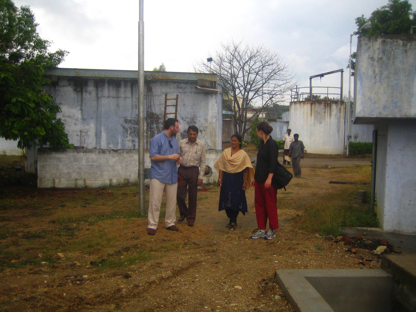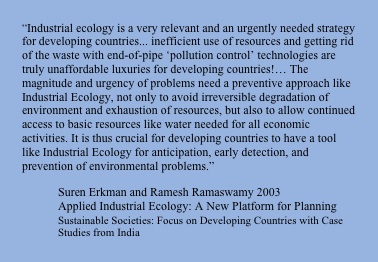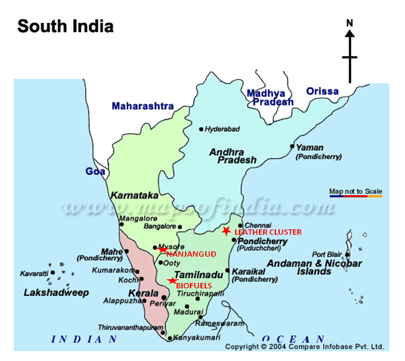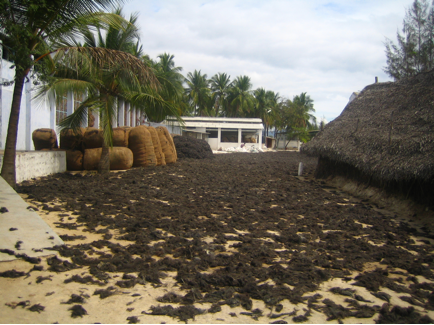Many scholars have argued that industrial ecology is especially critical for developing countries where large populations with dramatically less wealth than in the west are urbanizing rapidly, making effective resource use all the more important.

Yale F&ES Masters students Edan Rotenberg and Ariana Bain speak with leather manufacturers in Ranipet, Tamil Nadu, March 2008. Photo courtesy Chris Starkey
- working with research partners to introduce industrial ecology concepts and tools and build capacity for their use in host organizations and in the broader communities where partners are located
- utilizing research resources at Yale and other institutions to work on environmental challenges facing specific industrial regions in India
- highlighting best practices in Indian industry to national and international audiences, and
- sharing and comparing practices across different regions in the developing world.

- the growing biofuels sector, in particular examining the life-cycle performance of biofuels crops and agricultural byproducts used as fuels
- single industry-dominated clusters and mixed industry clusters with an emphasis on identifying and promoting opportunities for resource exchange and sharing where it is simultaneously economic and environmentally beneficial, and
- resource (energy, water) and waste management practices and infrastructure, with an objective to improve these aspects
Research Project Map

In Spring 2008, one of our graduate student research teams documented the history and environmental characteristics of leather tanning and manufacturing activities in the Vellore region, west of Chennai in the state of Tamil Nadu, and highlighted the success of collaborative efforts in shared wastewater treatment.
India produces or processes at some stage, approximately 10% of all of the world’s leather, and nearly 50% of India’s production is in Tamil Nadu. The team visited the Central Leather Research Institute (CLRI) in Chennai and several tanning operations, leather manufacturing facilities and treatment plants in the industrial areas outside of Chennai. The leather industry was first established in the Vellore district in the 19th century to utilize abundant groundwater resources and serve Chennai’s textile markets. Since that time, reduced stream flow – a result of upstream diversion in dams – as well as direct discharge of untreated industrial effluent resulted in such high levels of groundwater salinity that this source became non-potable and unfit for most types of agriculture and even use by the industry itself.
To address these problems, CLRI and the Tamil Nadu Pollution Control Board (TNPCB) embarked on a program to supervise cleanup operations at tanneries and establish on-site treatment or connections to central effluent treatment plants (CETPs). CETPs play a major role in providing cost-effective treatment for groups of factories, and along with Waste Minimization Circles, create collaborative approaches to environmental management in the region. CLRI has also helped build landfills and introduce new treatment technologies such as reverse osmosis at the CETPs, and continues to conduct research into pollution control. In addition to clean-up efforts, significant strides have been made in reducing water consumption, which has decreased from 35L per kilogram of finished leather in 1996 to 10L-25L/kg today.
The team’s work highlights the importance of the Tamil Nadu Pollution Control Board for driving changes in environmental performance through regulation and direct intervention as well as the Central Leather Research Institute for working with industry to develop innovative solutions to their pollution problems. Our work suggests opportunities for improving working conditions in the sector and reducing salt pollution by examining upstream resource use in addition to activities at the tanneries.

Hair from animal hides, shipped to Australia for industrial felt/carpet making, March 2008. Photo courtesy Ariana Bain